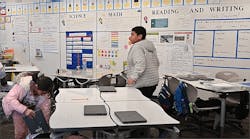Physical activity throughout the day helps keep students focused and enables them to expend extra energy. Whether using exercise balls as seats, stand-up desks or more traditional furniture options, items that facilitate movement are critical to help students succeed.
Traditional furniture pieces can meet the physical needs of students, keep them engaged and make them more successful. Here are a few things to keep in mind when investing in traditional classroom furniture for a moving classroom environment:
- Seating
No longer does sitting in chairs mean sitting still. To encourage student movement while seated, look for chairs that are ergonomically designed and that have foot rests.
-
Ergonomics: In order for students to succeed, they need to be comfortable and supported physically while sitting. Chairs must provide a natural posture for students, while also being flexible and enabling a broader range of movement.
-
Foot rests: Children typically have a high amount of pent-up energy and have a natural tendency to fidget. A great way to help students expend extra energy and relieve restlessness is with a sturdy foot rest or book rack beneath the chair on which they can tap or bounce their feet.
-
- Tables
Tables and desks may not be the first thing that comes to mind when thinking of a moving classroom, but these pieces are important. To encourage more physical activity throughout the day, look for workspaces that can be grouped and easily moved.
-
Groupability: When selecting workspaces, choose tables that can be grouped together or stand alone, such as furniture designed for collaborative learning. Periodic desk groupings not only get students out of their seats and moving around, but also facilitate group learning, which encourages more physical movement from students (e.g., talking with hands and exaggerated facial expressions.)
-
Portability: Not all learning activities take place at seated workspaces, so be sure to select tables and desks that can be moved easily and enable open areas to be created when full-body activities are introduced. Look for workspaces that are lightweight and set on casters.
-
Space planners should keep many things in mind when creating a classroom that encourages movement. Whether you choose to purchase trend items for now, or invest in more traditional furniture pieces for the future, give careful consideration to all aspects of the decision. Remember that any effort to encourage movement in the classroom will benefit students.
Amee Meghani is a product engineer for Smith System, Arlington, Texas.

